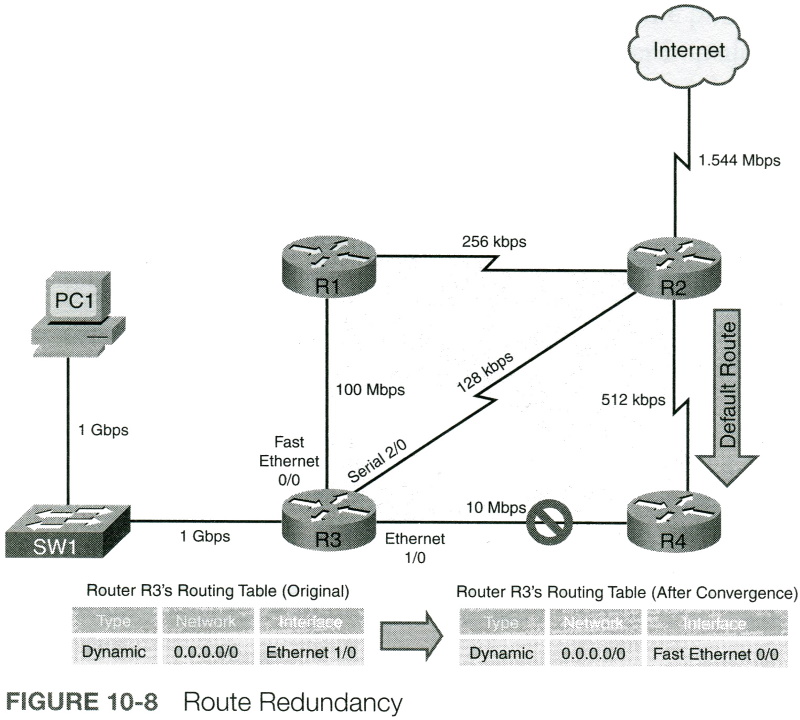
In complex networks, such as the topology shown in figure 10-7, static routing does not scale well. Fortunately, a variety of dynamic routing protocols are available that allow a router's routing table to be updated as network conditions change.
In figure 10-7, router R2 is advertising a default route to its neighbors (routers R1, R3, and R4). What happens if PC1 wants to send traffic to the Internet? PC1's default gateway is router R3, and router R3 has received three default routes. Which one does it use?
Router R 3's path selection depends on the dynamic routing protocol being used. A routing protocol such as Routing Information Protocol (RIP) would make the path selection based on the number of routers that must be used to reach the Internet (that is,hop count). Based on the topology presented, router R3 would select the 128Kbps link (where Kbps stands for kilobits per second, meaning thousands of bits per second) connecting to router R2 because the Internet would be only one hop away. If router R3 instead selected a path pointing to either router R1 or R4, the Internet would be two hops away.
However, based on the link bandwidth, you can see that the path from router R3 to router R2 is suboptimal. Unfortunately, RIP does not consider available bandwidth when making its route selection. Some other protocols, such as Open Shortest Path First (OSPF), can consider available bandwidth when making their routing decisions.

Dynamic routes also allow a router to reroute around a failed link. For example, in figure 10-8, router R3 prefers to reach the Internet via router R4. However, the link between routers R3 and R4 goes down. Thanks to a dynamic routing protocol, router R3 knows of two other paths to reach the Internet, and it selects the next-best path, which is via router R1 in this example. This process of failing over from one route to a backup route is called convergence.
About The Author
Anthony Sequeira, CCIE No. 15626, is a Cisco Certified Systems Instructor (CCSI) and author regarding all levels and tracks of Cisco Certification. Anthony formally began his career in the information technology industry in 1994 with IBM in Tampa, Florida. He quickly formed his own computer consultancy, Computer Solutions, and then discovered his true passion-teaching and writing about Microsoft and Cisco technologies. Anthony joined Mastering Computers in 1996 and lectured to massive audiences around the world about the latest in computer technologies. Mastering Computers became the revolutionary online training company, KnowledgeNet, and Anthony trained there for many years. Anthony is currently pursuing his second CCIE in the area of Security and is a full-time instructor for the next-generation of KnowledgeNet, StormWind.com. Anthony is also a VMware Certified Professional.
CompTIA Network+ N10-008 Cert Guide contains proven study features that allow you to succeed on the exam the first time. Expert instructor Anthony Sequeira shares preparation hints and test-taking tips, helping you identify areas of weakness and improve both your conceptual knowledge and hands-on skills, essential for successful completion of the performance-based testing items on the exam. This complete, CompTIA-approved study package includes the following:
• A test-preparation routine proven to help you pass the exams
• Clearly defined chapter learning objectives covering all N10-008 exam topics
• Chapter-ending review questions and exam preparation exercises, which help you drill on key concepts you must know thoroughly
• The powerful Pearson Test Prep practice test software, complete with hundreds of well-reviewed, exam-realistic questions, customization options, and detailed performance reports
• 40 performance-based exercises to help you prepare for the hands-on exam questions
• A free copy of the CompTIA Network+ N10-008 Simulator Lite software, complete with meaningful lab exercises that enhance your hands-on skills
• More than 60 minutes of video mentoring
• A final preparation chapter that guides you through tools and resources to help you craft your review and test taking strategies
• An Exam Essentials appendix that quickly recaps all major chapter topics for easy reference, both in print and interactive digital format
• A key terms Glossary in both print and on the companion website, which acts as an interactive flash-card application
• Study plan suggestions and templates to help you organize and optimize your study time
• A 10% exam discount voucher (a $33+ value!)
Well regarded for its level of detail, study plans, assessment features, challenging review questions and exercises, video instruction, and hands-on labs, this approved study guide helps you master the concepts and techniques that ensure your exam success.
Master the topics on the CompTIA Network+ N10-008 exam, including:
• Network topologies and media types
• IP addressing
• Network services
• Data center architectures and cloud concepts
• Routing, Ethernet switching, and wireless networking
• Network availability and disaster recovery
• Network security
• Remote access
• Network troubleshooting
Reader Paulo Cardoso says, "This is a great book. In addition, it comes with great additional resources."
Learn more about the CompTIA Network+ N10-008 Cert Guide at amazon.com
More Networking Protocols and Standards:
• IP Addressing and Subnetting
• TCP Windowing
• Ports and Sockets
• Wireless Network Standards - 80211a, 80211b, 80211g, 80211n, 80216
• Neighbor Discovery Protocol (NDP)
• NTP Server Systems - The Network Time Protocol
• What Is Fabric Networking?
• IGRP (Interior Gateway Routing Protocol)
• 14 Common Network Ports You Should Know
• Internet Protocol versions IPv4, IPv5 and IPv6



